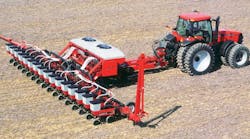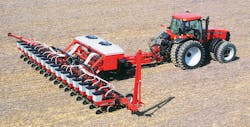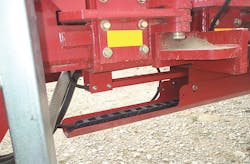As with most agricultural equipment, 1200 Series planters, from Case IH, make extensive use of hydraulics. But these planters rely on hydraulics not only for their main objective — planting seed — but for transforming them from a 40-ft wide planter to a road-ready trailer as well.
Michael Pruett, of Case IH, explains that for the planting operation, the Case IH planters use two pairs of hydraulic orbital motors. One pair drives a fan that creates a vacuum to draw seed from each of two storage bins. A second pair of motors drives blowers that transport the seed to individual planting stations.
This configuration, Pruett points out, enables the Case IH planters to work with a wide range of seed sizes. Farmers, therefore, are free to take advantage of the latest hybrid seed, which often are a different size or shape than conventional seed. Otherwise, seed may be planted with poor seed-to-soil contact or poor in-row spacing.
The 1200 Series comes in five models and 18 configurations with hydraulics either powered by a tractor's PTO or self-contained hydraulic system. In all cases, the 1200 Series plants more area in less time and with greater accuracy (meaning higher yield per seed) than competitive planters.
A winning hand with hydraulics
When in operation, the planter is roughly 40-ft wide — obviously too wide for transport over public roads. To make the planter road-ready, three operations are performed, all using hydraulics. First, two hydraulic cylinders pivot two horizontal members upward to where they are vertical and parallel. Next, another pair of cylinders pivots the assembly downward and rearward.
At this point the planter is only 14½-ft wide, which is narrow enough to be transported on public roads. To complete the transformation, a fifth cylinder extends a towing tongue forward. After the operator disconnects it from the tractor's PTO or hydraulic connection — and performs other tasks to transform the planter into a trailer — the planter is ready to be towed to another location.
Know when to fold 'em
One detail of preparing the 1200 planter for transport that may not be immediately obvious is how to manage long lengths of hydraulic hose. Ignoring this detail could lead to tangled or pinched hoses, which could shorten hose life or hydraulic fluid leakage. To keep hoses neat and orderly, engineers at Case IH chose to use System E2 Energy Chain, from Igus Inc., East Providence, R.I.
The Energy Chain not only protects and secures hydraulic hoses, but its open design prevents debris from accumulating inside the carrier, reducing maintenance. The Energy Chain also tolerates daily exposure to crop residue, wheat stubble, and liquid fertilizer. Case IH engineers report that Energy Chain is simple, cost-effective, and reliable when compared to more expensive solutions, and expect it to last the life of the machine — at least 10 years.



